
Newport, Oregon sign in Kenmore Square
Fenway park opening day is April 3rd. Fans traveling to Fenway via Kenmore Square will see something new this year:

This past winter the City of Boston put up the unusual sign in Kenmore Square to signify the length of Route 20.
Things I learned about Route 20
- Route 20 is the longest route in the United States.
- Route 20 didn't connect both coasts until
- According to Google Maps, it would take 48 hours to travel between Boston and Newport, Oregon. The best route isn't Route 20, but rather I-90 W and I-80 W.
- In Sudbury, Henry Ford paid for a bypass road when trucks would go down the road really fast and caused structure issues at the Wayside Inn.
- Route 20 makes a slight disappearance in Yellowstone National Park.
Finding the sign
The sign is a little small and may be hard to spot. The sign is located at the corner of Kenmore Street and Commonwealth Ave. It's located near the MBTA bus station at Kenmore Square.
If your driving into Kenmore Square, your better off seeing it coming in via Commonwealth Ave. The sign will be on your left just before you get into Kenmore Square.
If you're taking the Green Line to Kenmore Square, you'll want to use the Beacon Street Exit. Once you're at street level, head to the lights at Kenmore Street, away from the Citgo Sign, then cross the street. You'll see the sign as you look back towards the Citgo sign.
PermalinkBoston Spring
Spring has officially arrived and pretty soon things will get busy in the City of Boston. Here are some notable openings that pretty much guarantee that the warmer weather is here to stay for a while.
| February 25, 2017 | Sullivan's at Castle Island |
| March 22, 2017 | Duck Boat Tours |
| March 25, 2017 | Greenway Carousel at The Tiffany & Co. Foundation Grove |
| April 3, 2017 | Red Sox Opening Day |
| April 17, 2017 | Boston Marathon |
| April 30, 2017 | Christian Science Center Reflection Pool |
Visual Graphic
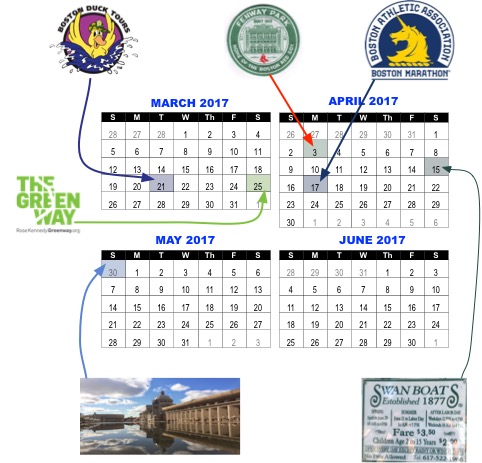
Download a higher resolution chart
Missing Anything?
Is there anything that I am missing that you think that should be mention here? Let me know in the comments.
PermalinkCharles F. Hurley
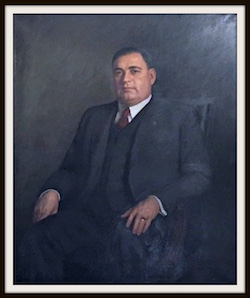
Charles F. Hurley was the 54th Governor of Massachusetts and is the first Irish Governor of Massachusetts. He only served one term from January 7, 1937, to January 5, 1939. He represented the Democratic Party.
Since tomorrow is Saint Patrick's Day, I thought it would be interesting to learn more about Massachusetts first Irish Governor.
Things I learned about Charles F. Hurley:
- Graduated from Boston College in 1913
- Was the Massachusetts State Treasure for three terms and was the first to step up from that position to governorship.
- He won 47.62% of the votes in the Massachusetts Governor Race in 1936.
- Under Gov. Charles F. Hurley the state budget was $70,117,030
- Has three Daughters Nancy, Ellen Sarah, Betty and a son Charles F. Jr.
- As Governor he received a kidnap threat against his daughters.
- Two days later Edmund E. Farrell was arrested for sending the letters. He admitted to sending the letter.
- Was one of the few Democratic Governors to have concerns about the "New Deal" by President Franklin Roosevelt
- He authorized a minimum wage for women and children
- The Fair Trade Laws were passed - which allowed manufactures to set the minimum retail price on goods.
- He was that the dedication of the Paul Revere statue in the North End.
- Inherited a forty-acres estate in Ireland by his Uncle Timothy.
- Lost at a chance for a second term to former Governor James Michael Curley in the gubernatorial nomination.
- He died on March 24, 1946
Charles F. Hurley Building
Obviously was named after the former Governor. It is the only monument/building to honor the former governor.
- Designed by Shepley, Bulfinch, Richardson, and Abbott.
- Constructed by the Vappi Construction Company
- Building also known as the "Health, Welfare and Education Service Center for the Commonwealth of Massachusetts"
- Opened in 1971
- The front of the building was used in the movie 'The Departed' as the entrance to the Police Station.
Charles F. Hurley Painting

The painting in the hallway of the Massachusetts State House.
You can see the painting of Charles F. Hurley, and other Massachusetts governors at the Massachusetts State House. Charles F. Hurley painting is on the third floor between the Secretary of State office and the State Library. You have to go up the stairs and all the way in the back of the building.
I learned that the sitting Massachusetts Governor can put any hallway painting in the Executive Office. They decorate the office with paintings of past Governors that they admire.
PermalinkIrish Famine Memorial
The Irish Famine was a period of mass starvation, disease, and emigration in Ireland between 1845 and 1852. As a result of the Famine, the country population drop 25%.
The famine was caused by mold that was growing on the potatoes. Many Irish depended on potatoes as the food source due to strict land regulations. In addition, years of oppression on the Catholic Irish caused people to live just below the poverty line.
Boston was seen as a beacon of hope, and many Irish emigrated to the Commonwealth of Massachusetts to escape the rough conditions in Ireland.
The Irish suffered job discrimination with people putting up signs in store windows which read, "Irish need no apply." People saw the mass migration as a threat to the skillful workforce.
In 1998, Boston dedicated a memorial to the Irish Famine.
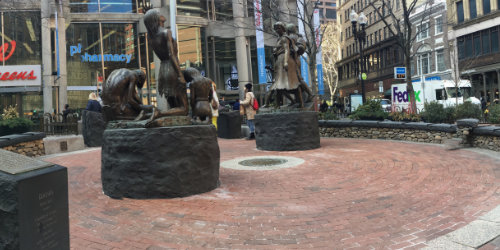
Things that I learned about the Irish Famine Memorial
- Cost $1 Million to put together
- Located on the Freedom Trail, across from the Old South meeting House
- The original idea for the memorial started in 1991, but never amounted to any real project
- Original location was to be someplace near Faneuil Hall
- Thomas J. Flatley took ownership of the project in 1996 and made the memorial a reality.
- More than 7,000 people attended the dedication on Sunday, June 28, 1998.
- Dedicated as part of the 150th anniversary of THE GREAT HUNGER.
- Cardinal Law visited the site after the Dedication Ceremony and blessed the memorial with Holy Water from Ireland.
- Robert Shure, of Skylight Studios, made the two statues.
- Robert Shure also created the statues at the Rhode Island Irish Famine Memorial which was dedicated on November 17, 2007.
- Robert Shure also did the Boston Marathon Memorial (!996) and the Massachusetts Fallen Fireman Memorial (2007).
- The two statues are Bronze on granite base.
- Thomas J. Flatley, Committee Chairman, was an immigrant who arrived from Ireland in 1950 with $32 in his pocket.
- Thomas J. Flatley, died on May 17, 2008 with an estimated net worth of $1.3 billion.
What are the statues of?
There are two statue monuments in the memorial.
- One of the statues show a family suffering from the Famine. ( It looks very similar to an 1849 depiction of Bridget O'Donnell and her two children during the famine.)
- The other shows a family doing well.
Some people say that the two monuments demonstrate how the potato famine impacted the poor and the rich.
The Eight Plaques
There are eight plaques around the memorial which tells the cause and effect of the Irish Famine:
- Dying of Hunger - Starting in 1845, a virulent fungus devastated the potato crop....
- AN GORTA MOR - The Great Hunger of 1845-50
- The People were Gaunt - Starvation and disease spread across the Irish landscape claiming 1 million lives
- Boston Sends Help - On March 27, 1847 Boston sends a ship of supplies.
- Crossing the Bowl of Tears -Two Million people fled Ireland in vessels that were called Coffin Ships.
- Arriving in Boston - In 1847, 37,000 Irish arrived in Boston...
- The American Dream - Today 44 million American claim Irish ancestry
- Lest We Forget.- The conditions that produced the Irish famine...still exist today.
Memorial Location
The memorial is located on Boston's Freedom Trail at the corner of Washington St. and School St. It's right between the "Old Corner Bookstore" and the "Old South Meeting House."
The memorial is not an official site on the Boston Freedom Trail.
PermalinkCoconut Grove Night Club Fire
In 1942 one of the world's worst nightclub fire happen in Boston. On the night of November 28, 1942, 491 people died at the Coconut Grove nightclub. This is still the worst nightclub fire in History.

Twelve things that I learned about the nightclub fire:
- The official cause of the Cocoanut Grove fires is being "of unknown origin"
- Most people died because of inadequate exits and toxic smoke
- One person killed himself at the hospital when he found that his wife died in the inferno. Official records count include this death in the records - 492 deaths as a results of the nightclub fire
- 160 people were injured in the fire
- The nightclub was zone to hold only 460 people.
- The main part of the fire was put out within 30 minutes of it starting.
- Buck Jones, a famous Movie cowboy star, died from injuries sustained from the fire
- Boston City Hospital and Massachusetts General Hospital treated burn victims
- At one point patients were arriving at Boston City Hospital every eleven seconds.
- Burn Hospital Victims were treated with penicillin the first time for the civilian population
- Barney Welansky, the owner of the club was convicted of manslaughter in connection and sent to prison for 12-15 years.
- Barney only served four years of the prison term.
As results of the fire
- New safety codes require all revolving doors must have regular outward-swinging doors nearby.
- New innovation to help burn victims
- New Legal rules on building owners on maintaining safe conditions to the buildings.
Piedmont Street Today
Today the site of the former nightclub is a parking garage and a large empty lot. The area of the original main dining room is now a new street called Coconut Grove Lane.
In 1993, on the 50th anniversary of the fire, a memorial plaque was placed at the original location of the nightclub. The plaque is placed on the sidewalk near where the revolving door was located. (Many of the victims died as a result of the rush to the revolving door.)
The plaque reads:
Erected by Bay Village Neighborhood Association. In Memory of the more than 490 people who died as a result of the Coconut Grove fire on November 28, 1942. As a result of this terrible tragedy major changes were made in the fire code and improvements in the treatment of burn victims no only in Boston but across the nation.
"Phoenix out of the Ashes"
This plaque crafted by Anthony P. Marra, Youngest Survivor of the Coconut Grove fire. You can see a map of the nightclub on the plaque, and the revolving door
Anthony P. Marra was a Cocoanut Grove Club employee who escaped the fire.
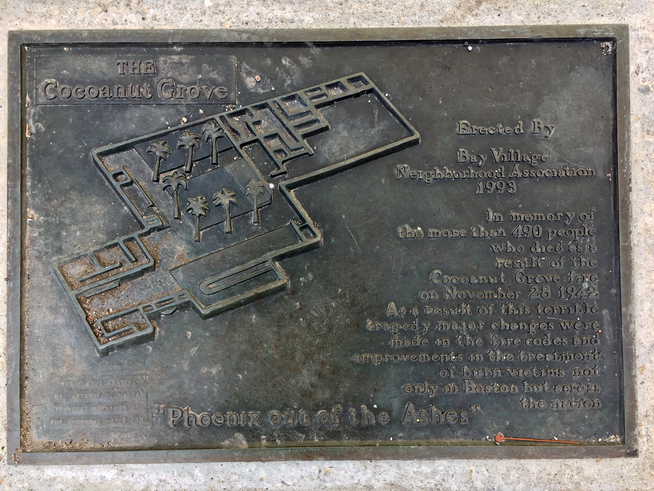
Location of the Plaque
The plaque is located at the corner of Piedmont Street and Coconut Grove Lane, (17 Piedmont Street.) It located just underneath the lamp post sign.
PermalinkOliver Ames Jr. Square
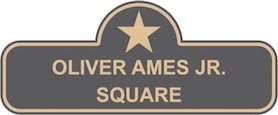
At the corner of Commonwealth Avenue and Charlesgate West, near Kenmore Square, is a sign indicating that it's Oliver Ames Jr Square. Did you know, that Boston had two famous Oliver Ames Jr?
- Oliver Ames Jr (1807 - 1877) - President of the Union Pacific Railroad
Key Accomplishment: Instrumental with completion of the first transcontinental Railroad in North America. - Oliver Ames Jr (1895 - 1918) - United States Army Officer
Key Accomplishment: A courteous kindly gentleman and a true soldier
The square is named for Lieutenant Oliver Ames Jr. who served in the 165th United States Infantry Regiment, part of the 42nd Infantry Division in World War One. On July 29th, 1918, he gave his life at the Second Battle of the Marne.
Oliver Ames Jr (1807 - 1877) is the father of Oliver Ames Jr (1895 - 1918)
Some interesting thing that I learned about Oliver Ames Jr:
- Born in Boston on April 8, 1885
- Married Caroline Lee Fessenden before the World War I
- Served in the 165th United States Infantry Regiment, part of the 42nd Infantry Division
- The 42nd Infantry Division was mostly made up of National Guard units.
- Served under Major "Wild Bill" Donovan
- Was killed by a German sniper who was hiding behind a dead horse at the Battle of the Ourcq River during the second battle of the Marne.
- He received the Distinguished Service Cross posthumously with the following text: "He fought gallantly until on the last day he was killed while going forward voluntarily through machine-gun and snipers' fire to the assistance of his battalion commander."
- In 1922, a book about him called "OLIVER AMES, J R - 1895-1918" by Mark Antony De Wolfe Howe published by Harvard Press
- The book contains actual letters that he wrote home from the frontline.

You can see the new "Boston Strong" sign from the square. The square is between the cars and the "Boston Strong" sign.
Burial Location
Oliver Ames Jr buried at the Oise-Aisne American Cemetery and Memorial in Picarde, France. His grave reads:
PermalinkOliver Ames, Jr. 2nd Lt. Inf. U. S. R. Killed in action, July 29th, 1918 Act. Adjutant 1st Btn. 65th Inf.
Mario Susi & Sons Marker
On Court Street, near the Washington Street intersection, if you look around the sidewalk you will see the following:
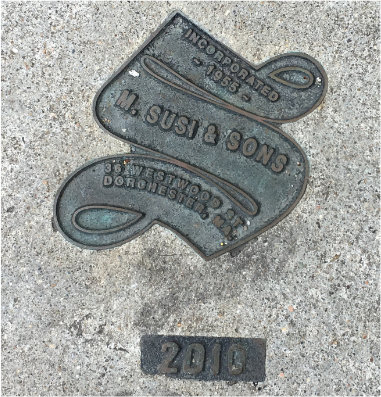
You can see these sidewalk markers in various places around the city of Boston. Mario Susi & Sons is an excavating contractor that has performed construction projects for the city of Boston.
What is an Excavating Contractor?
Excavation Contractors perform site preparation, grading, trenching and other various soil-related tasks. They basically get to drive around very large pieces of heavy equipment to get the job done.
Things I learned about Mario Susi & Sons
I wasn't able to find a lot about the company, which is surprising since they do a good job with streetside advertising.
- Company was founded in 1955
- Founded by Mario Susi and his sons Raymond Phillip Susi and Joseph Susi
- Approximately 20 full time employees
- $4.1 million in annual revenue
- Bids on various construction projects for Boston, Cambridge, Braintree and Milton
- In 1983, they did work around Medford Square - another place where you may find the marker on the sidewalk
- In 2007 they did some work Central Avenue/Eliot Street intersection in Milton where you may also find the above marker.
- Mario Susi died October 27 2005
- Raymond Phillip Susi died on March 20, 2014
- Joseph Susi died on February 26, 2016
- Website: msusi.com
- According to various posts, the are "one of the most well known and respected contractors in the Boston area"
"Then & Now" MOS Exhibit
Did you know that the Boston Museum of Science has an exhibit that looks back at some of the histories of the museum? You can take a step in time and look back at some of the famous exhibits at the museum.
You can read all about how the museum transformed from the Boston Society of Natural History in 1860 to what it is today.

Some of the features in this Exhibit
- Pictures of the Boston Society of Natural History
- Birds that were on display at the "Boston Society of Natural History"
- Pictures of some old Exhibits, remember the Hatch Egg?
- Pictures of the original Dinosaur and why they changed it.
- Pictures of Spooky - The Museums Great Horned Owl
- Turbidity Column Exhibit
- Interact with The Tooth Exhibit
- Interact with the first Interactive Exhibit, the Ermine.
- Watch a classic 1980s commercial of the Museum - Where its fun to find out"
This is a cool place to walk through if you visited the museum when you were a kid. You can see many familiar things from the museum past.
Finding the Exhibit
The "Then & Now" exhibit is on Level 2 in the Blue Wing, just beyond the Science in the Park in the Theater of Electricity.
Thanks to the Sponsors!
The exhibit was made possible through the generosity of Joan and Herman Suit, and the George Willard Smith Endowment Fund.
PermalinkWashington Portrait at the Boston Public Library
The Boston Public Library Central Branch is known for having a lot of beautiful architecture. Among the serious researchers in the library are tourists checking out the main marble staircase in the entrance hall and the various paintings in the Abbey room.
In the second floor of the McKim Building is the Washington Room. A few months ago this is where people would sit and do research on the computers - it was part of Tech Central. The computers might be gone, but the beauty of the room still exist.
The centerpiece of the room is the large picture of George Washington hanging over the desk in the room.
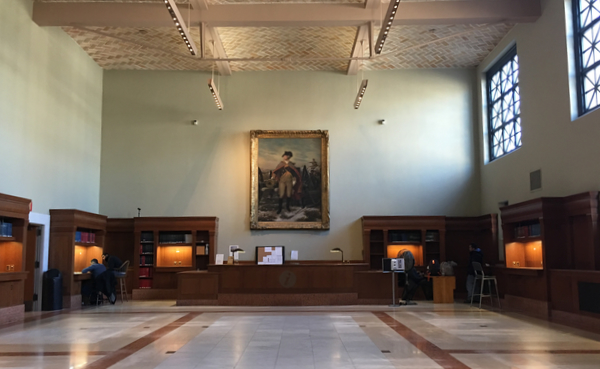
Washington at Dorchester Heights
by Emanuel Gottlieb Leutze
A sign near the desk reads...Known for his portraits and history paintings, German artist Emanuel Leutze selected a dramatic scene from the Revolutionary War for this enormous work, depicting General George Washington commanding his troops to occupy the hills of Dorchester Heights on the south side of Boston. This action by Washington and the Continental Army in 1776 proved instrumental in driving British forces out of the city, ending the nearly year-long siege of Boston.
The painting was purchased by the City of Boston with gifts from School Children and citizens from Vose Gallery in 1955.
About Vose Gallery
If you really like the art at the Boston Public Library, you should check out more contemporary pieces at the nearby Vose Gallery - which many tourists may not know about. Vose Galleries specializes in 18th, 19th, and early 20th-century American paintings. America's oldest family-owned art gallery, Vose has founded 160 years ago.
Family-owned gallery features American Impressionist art along with contemporary pieces by realists.
They are located at 238 Newbury Street. Getting there from the library is easy, simply walk out the main library doors by Boylston Street and cross Boylston Street. Take a right on Exeter Street, and then a left on Newbury Street. The Vose Gallery will be on the left side about 1/2 block down, it's right next to CVS. Just before Fairfield Street.
Free Library Tours
The Boston Public Library offers daily tours highlighting the architecture of its famed Central Library buildings by Charles Follen McKim and Philip Johnson as well as the art treasures within, including works by Daniel Chester French and John Singer Sargent.
The tours start near the McKim Entrance, stop by the one of the borrower services desks for information on the next tour.
PermalinkBoston Logan International Airport
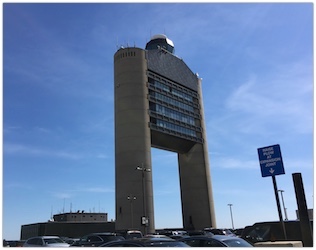
Boston Logan International Airport (IATA Code BOS) is the largest airport in New England. Most New Englanders call the airport, simply "Logan."
Since we are going to be flying out of the airport soon, I thought it would be interesting to learn a bit about the airport. Here are some things that I have learned about the airport.
Airport History
- The original airfield was created by the United States Army
- First airplane to land on the field was on June 13, 1923.
- That's 19 years, 5 months, 27 days after the Wright Brothers first flight.
- Commercial Aircraft started flying out in 1927.
- In 1927, Charles Lindbergh and the "Spirit of St. Louis" landed in Boston after a solo flight across the Atlantic
- Official Name is the General Edward Lawrence Logan Airport. (June 12, 1943)
- Previous Name was the Commonwealth Airport, some people may refer to it as the "East Boston Airport"
- In 1947, the airport became International with passenger flights to Canada, Bermuda, Lisbon and London.
- In 1959, Massport took over the airport
- In 1973, Massport built a 22-story airport control tower. (The largest in the world.)
- Today the Airport covers 2,384 acres and six runways.
- Currently rank 17th busiest airport in the United States.
- The Airbus A380 is the largest passenger aircraft to ever have landed at the airport.
- Private Planes can land at Logan Airport. Departure Fees start at $10 daytime. Nighttime field use starts at $59. - Massport Aircraft Operating & Parking Fees
General Edward Lawrence Logan
- Born in South Boston and Graduated from Boston Latin
- Served in the 9th Massachusetts Regiment in 1897
- Commanded the 101st Regiment in World War I
- Justice of the South Boston Court in 1914
- Died July 6, 1939 and buried at Mount Calvary Cemetery
- A statue of General Logan by Joseph Coletti was unveiled at the entrance to the former Boston Airport when it was officially renamed the General Edward Lawrence Logan International Airport in a public ceremony in 1956.
- The statue has been moved with each major airport expansion.
- The statue is currently located on Porter Street. You will see it on your left as you get on the Massachusetts Turnpike.
The joke around the city is that the airport is named after an infrequent flier. The question is: Why did Boston name an airport after General Edward Lawrence Logan? For all of his many accomplishments, Lieutenant General Logan never flew in an airplane.
PermalinkAbout
There are many interesting things and places around Boston, MA that you should know about. Here are a few that caught my attention. From historical sites such as the USS Constitution Museum, the Freedom Trail, and the iconic Fenway Park, to modern attractions like the New England Aquarium, the Boston Public Market, and the Isabella Stewart Gardner Museum, there is something for everyone. Whether you are looking for a fun family trip or a romantic getaway, Boston has it all.
Check out all the blog posts.
Blog Schedule
| Friday 4 | Macintosh |
| Saturday 5 | Internet Tools |
| Sunday 6 | Misc |
| Monday 7 | Media |
| Tuesday 8 | QA |
| Wednesday 9 | Pytest |
| Thursday 10 | PlayWright |
Other Posts
- Ghost Encounter at the Boston Athenaeum
- Jean Louis Lefebvre De Cheverus
- Five Napkin Burger Closes in Boston
- Happy Place
- Spanish/American War Cannons
- American Congregational Building
- Magic 106.7
- Charles Hilgenhurst Medallion
- One Pinckney Street
- Washington Portrait at the Boston Public Library
- David Ortiz Bridge
- Top of the Hub and SkyWalk Closing
- Prudential Skywalk Observatory
- The Christian Science Plaza
- Democratic Donkey